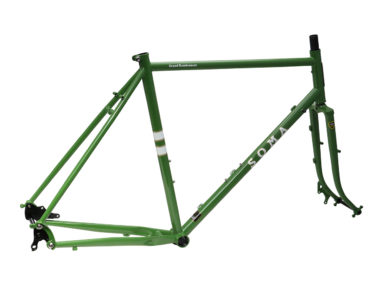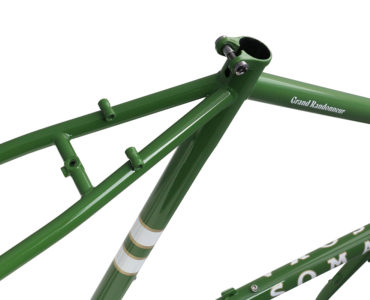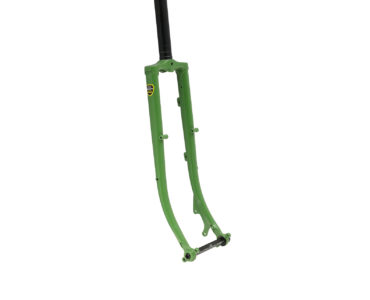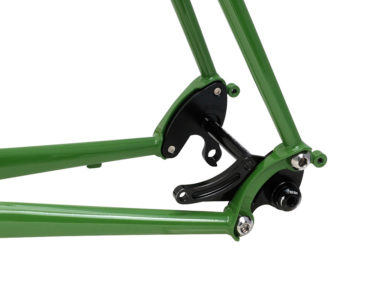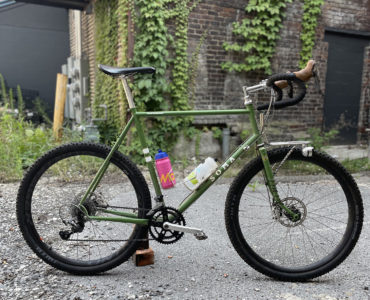Grand Randonneur Disc Frameset (Randonneuring / 650b Endurance Road Disc)
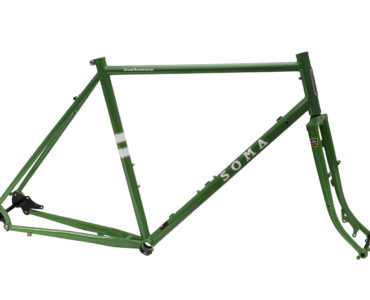
The Grand Randonneur is a svelte road frame optimized to carry a front load. We have equipped it with rear rack mounts, but it feels best with a loaded front mini rack or a handlebar bag.
The version 3 of the "Grando" makes quite a few updates:
• The geometry is still low trail in the front, but we have tried to make the handling slightly more stable than version 1 and 2.
• We have tweaked the tubing mix to add stiffness at the bottom bracket, while keeping this frame still our lightest model.
• We have modernized parts of it: Adding IS disc mounts and thru-axle hubs compatibility. And of course everyone wants just slightly more tire clearance.
• With its skinny steel tubes and 1" threaded lugged crown fork it still has the vintage road bike look.
Specifications:
• Tange Prestige CrMo tubes, double-butted
• Threaded 1" lugged crown fork is equipped with low rider pannier bosses, mini rack eyelets and double eyelets at the dropouts. Thru-axle hub compatible. IS disc mounts
• Designed for 650b wheels
• Max. tire fit: 650 x 47mm semi-knob tire
(Max. fender width: 50mm)
• Tange Modular rear dropouts: Stock set up is for 142mm x 12mm thru-axle with IS disc mounts. Alternative styles available thru Tange/Long Shen.
• Rear rack and fender eyelets
• Pump peg at headtube
• Two sets of water bosses
• Headset type: 1" ISO Threaded external cups(EC30/25.4 | EC30/26) (Needle/Roller bearings recommended)
• Seatpost fit: 27.2mm
• Weight: Frame: 4.5 lbs Fork: 2.45 lbs
• Paint: Moss Green
Grand Randonneur Disc Frameset (Randonneuring / 650b Endurance Road Disc)
-
Specifications and Recommendations:
- Headset: 1" threaded, external cup, 26.4mm crown, (needle bearing or roller bearing-equipped headsets highly recommended for low trail forks)
- Seatpost: 27.2mm
- Front derailleur: 28.6mm, bottom pull
- Rear hub type: 142 x 12mm thru-axle
- Front hub type: 100 x 12mm thru-axle
- Tires: 650b x 38 to 47mm
- Fork rake: 65mm
- Max chainring fit: 52-42-32t with a 45mm chainline. 53-39t, with a 48.5mm chainline (this is not a chainline recommendation!)
- Bottom bracket shell: 68mm wide, English threads
- Brake compatibility: IS mount disc, 160mm rotor
- Compatible with downtube shifters
- Weight limit (including rider and cargo): Size 56cm and smaller: 250 lbs / Size 58cm and larger: 270 lbs - This type of bike rides best with a front load. You can ride it unloaded, but it will take time to get used to the steering qualities of a low trail geometry. See FAQ entry on "Things to Know About Riding A Low Trail Bike" -
Things To Know About Riding A Low Trail Randonneuring Bike
There are growing ranks of cyclists who prefer a low trail bike, primarily because of the way it handles with a medium front load like a handlebar bag. The Grand Randonneur and bikes like it have a fork offset 20mm or more than the average road bike. While road bikes have a trail number of 55-65 and mountain bikes have a trail numbers 70 to 90mm, the Grand Randonneur has a trail number of about 37 to 47mm.
A properly designed low trail bike, when carrying a load up front, responds less to the weight while steering. The basket, bag, or pannier won't yank on the bars as much, especially when initiating turns.
The Grand Randonneur uses lighter tubing than our other road bikes and a fork with a more pronounced bend to create a more comfortable ride over long distances. Because of that and the low trail design, we don't recommend it for fully loaded touring. It is a performance bike designed for carrying a light to medium front load at speeds in relative comfort over long distances.
A low trail bike is not necessarily a great fit for every rider and their bike needs.
These GENERAL observations from Bicycle Quarterly and others may help you determine if you want to try it out and help fine tune the ride of your bike.
1) Low trail bikes ride best with tires at least 650b x 36mm wide and preferably at lower tire pressure (55-60psi). Some claim 42mm is ideal. (If using 700c, a 28c or wider tire may be better.)
2) Low trail bikes handle differently than most bikes you've tried. Without a load in front the steering feels light especially at low speeds. This is because it has less wheel flop. It may take just one long ride to get used to it or weeks or months – depends on the rider.
3) Low trail bikes tend to be more controllable on speedy corners. Steering in more intuitive in instances where you set up the bike and don't turn the bars much.
4) Low trail bikes are easier to hold a straight line in climbs. Less apt to wander.
5) Low trail bikes feel hard to maneuver at slow speeds. Not as good as a high trail bike on tight switch backs and singletrack.
6) Low trail means the bike handles a front load better than typical high trail bikes. You don't have to fight the load as much when riding.
But low trail can also means it handles poorly if you only carry a load in the rear. If you need to carry items on other parts of the bike, consider a frame bag. And if you do opt for a rear rack and panniers, distribute weight 60% front / 40% rear.
7) There is some evidence that light weight low trail bicycles are more apt to shimmy (speed wobble) in certain riding conditions; however shimmy is not at all exclusive to low trail bikes. And sometimes shimmy is rider-specific (i.e. a rider experiencing shimmy hands off the bike to a friend to try and the friend can't get the bike to shimmy at all)
7) Larger circumference tires increase trail (reduces the effects of low trail). A 650b x 50mm tire will make the bicycle handle differently than a 650b x 38. -
Don't low trail bicycles suffer from "fork shimmy" and how does Soma address it?
Some riders with lightweight low trail bikes do experience varying levels of fork shimmy (aka speed wobble) during speedy descents. (Shimmy can also occur on common mid trail road bikes, too.)
Cycling Tips gave this wonderful "Star Trek" definition of what causes shimmy. "When shimmy does occur, it’s a case of the bike-and-rider system oscillating at its 'resonant frequency' — the system’s natural frequency of oscillation, as determined by the physical parameters of that system. Think of the sound a crystal glass makes when you run a wet finger around its rim — this is another example of a system vibrating at its resonant frequency."
There isn't a consensus on what causes it or how to get rid of it. Some riders seem more prone to it than others. Some say that shivering on a cold day or gripping the bars too tightly can set it off. To get it to stop try making a slight change in how you are riding. If your hands were off the bar, put your hands back on. If you were gripping the bars tightly, maybe relax your arms. Resting your knee on the side of the top tube also may dampen the frame's oscillations and lower it from its "resonant frequency".
Installing a roller bearing (aka needle bearing) headset may help get reduce it. Some say to avoid putting your seat too back or raising the bars higher than the saddle can also help reduce its incidence.
In the version 3 Grand Randonneur, we have changed a couple things that may reduce the incidence of shimmy.
- The new larger 31.8mm OD down tube not only stiffens up the bottom bracket but has different resonant frequency than the slender top tube and headtube. 61 and 65cm frames have a larger 34.9mm down tube)
- The reduced fork rake increases trail slightly
- Switching to thru-axles stiffen the fork and wheel which may better resist Hopf bifurcation
Grand Randonneur Disc Frameset (Randonneuring / 650b Endurance Road Disc)
-
All in All, Pleased
“Mine is a 52. I have GRX 810 components with a 48x31 chainring and 11-34 cassette. I love KOM wheels on my 700C bike so I have KOM wheels on my 650B with Rene Hearse 42s set up tubeless.
I read about the shimmy problem and chose my head set (roller bearing) accordingly and have zero issues with shimmy. I have it setup for randonneuring with a Swift handlebar bag and a rear rack for trunk bag. I originally ordered the Rene Hearse Rando handlebars, but after the fit, I switched to a Richie of the same width but with a different geometry that worked much better with my reach. I have a Schmidt generator hub in the front and a White Industries hub in the rear. For fenders, I got the Velo Orange Snakeskin.
All in all, I am pleased with the bike. I find it a comfortable ride. This steel frame is heavier than my titanium frame bike and I am a bit slower on the Soma.”Rob T., ,
-
Reader's Rig: Bill's Soma Grand Randonneur
“I’ve owned countless bikes over the years (seen here), but the Grand Randonneur is by far my favorite. It’s the most comfortable and capable bike I’ve had in my stable and one I could never see myself parting with!...
I always loved the idea of front-load-carrying bikes dating back to my messenger days. I spent a handful of years schlepping around file boxes and knew whatever bike I owned would be front rackable. While most of my riding is in the city—commuting, small grocery runs, and picnics in the park—I enjoy riding the many trails in the area, both paved and unpaved. The Soma handles all the with ease and allows me to just ride wherever I feel like without worry....
Prior to building the Soma, I owned a Surly Pack Rat, which was my favorite bike up to that point. It was Frankensteined to hell, with a Straggler fork and rear disc tab welded on. I loved that thing but desired something equally as functional but way more stylish. It had to be low trail, had to be green, and had to look good.... ( https://bikepacking.com/news/readers-rig-bills-soma-grand-randonneur-v3/ )”Bill, Seattle, WA
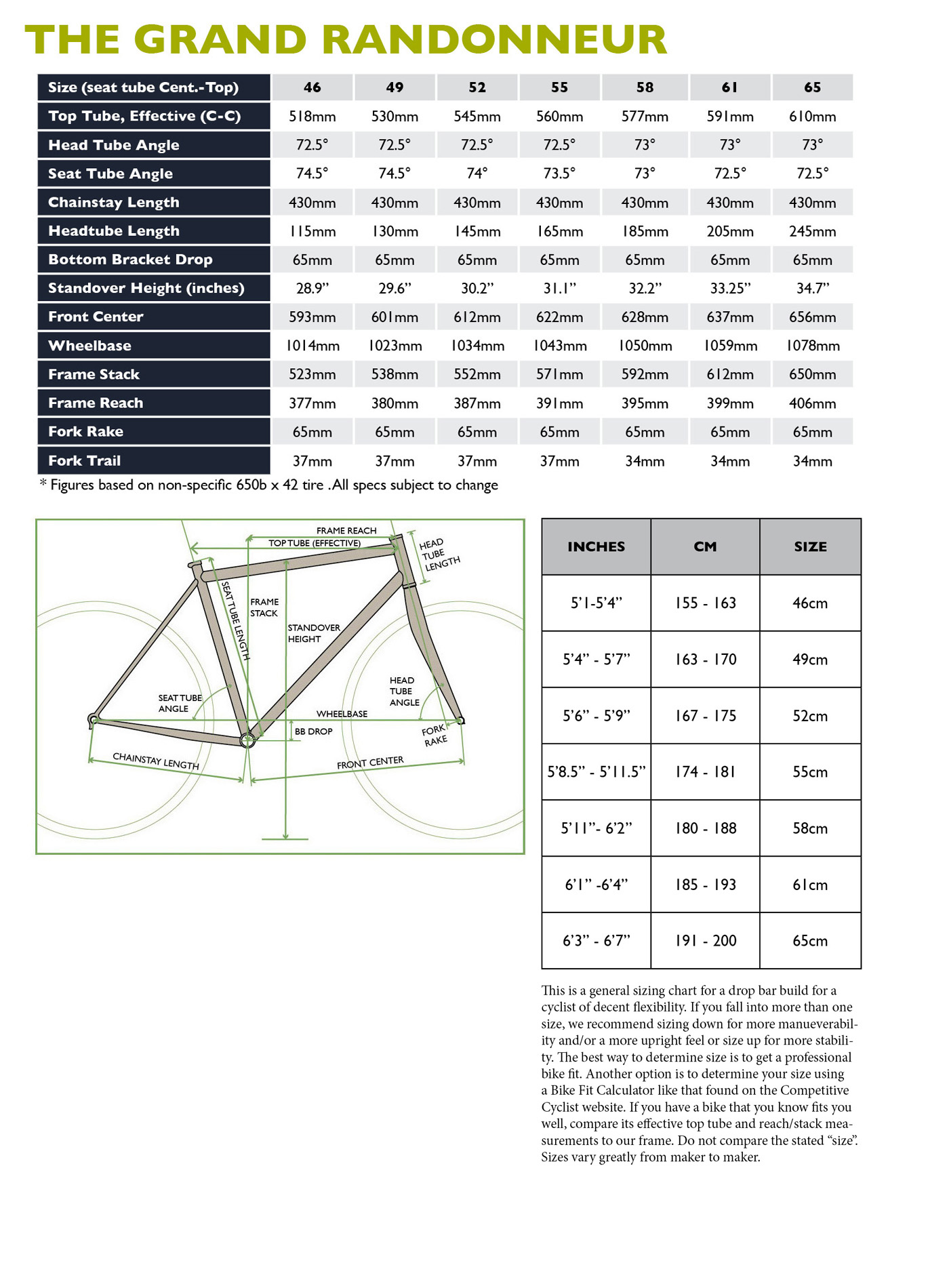
Grand Randonneur Disc Frameset (Randonneuring / 650b Endurance Road Disc)
-
Road Bike, Not A Racing Bike!
This was a video review. Some highlights of the review:
- Found the 1" headtube/quill stem set added some comfortable flex over common 1-1/8" headtube/threadless stem set ups
- Low trail handling not as noticeable as on other low trail bikes he's owned/tested. (maybe b/c of the 650 x 50mm tires)
- Low trail handling was noticeable on climbs where the steering wandered less than higher trail bikes.
- "The perfect road bike (not racing bike) for most people" -
Finding an Ideal Low Trail Road Bike
The Soma Grand Randonneur really shines on long road rides. The bike is so comfortable that I stop less than I would on a more aggressive road bike. I find that longer road rides are some of my favorite days on the bike, and this bike reminds you that it doesn't have to be a race.... With about 15 pounds of gear, the bike handled predictably and the geometry was comfortable for full days in the saddle. As long as you can keep your camping setup lightweight, the Grand Randonneur does great on tour.... The bike really comes alive when you set it up as it’s intended to be, a Randonneuring bike. The bike does great with a rack and bag on the front end, with everything you need sitting on that front rack. ( https://theradavist.com/soma-grand-randonneur-review )
